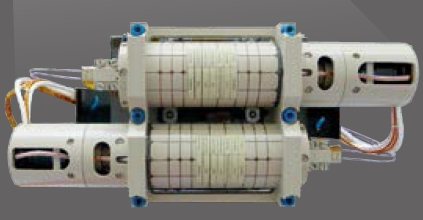ASM Overview
Instrument description

The Absolute Scalar Magnetometer (ASM) on the Swarm satellites measures the strength of the magnetic field to greater accuracy than any other magnetometer. It provides scalar measurements of the magnetic field to calibrate the Vector Field Magnetometer (VFM).
The objective is to measure magnetic field strength and to calibrate the VFM device to maintain absolute accuracy during the mission. The ASM characteristics make the instrument ideally suited not only for the traditional role of scalar magnetometers as absolute references for the calibration of the on-board vector instruments, but also for extended operational capacities, such as higher frequency scalar measurements (of potential interest for magnetosphere studies for the low frequency part of the spectrum) or autonomous scalar / vector operations. Also, the helium magnetometer can be operated in a zero field configuration with only very minor evolutions in the sensor overall design, thus extending its initial capabilities to new missions in planetary exploration.
Design

The ASM is based on the ESR (Electron Spin Resonance) principle and makes use of the Zeeman effect which splits the emission and absorption lines of atoms in an ambient magnetic field. The pattern and amount of splitting is a signature of the magnetic field strength. The optically pumped helium magnetometer uses a High Frequency (HF) discharge within a gas cell to excite 4He atoms from the ground state to the metastable state. This metastable level is split by the Earth magnetic field into three Zeeman sublevels. The separation of those sublevels is directly proportional to the ambient field strength and equals half the gyro frequency (eB/2m - where m is the electron mass).
Using this measurement principle enables ASM to determine the magnetic field strength with high sensitivity and performance, which remains identical at all points in the orbit. ASM makes absolute measurements without any drift or bias. ASM can also determine components of the magnetic field along three axes perpendicular to each other resulting in magnetic field vector measurements that can be used to compare Vector Field Magnetometer against ASM data to verify the design of the ASM sensor for future missions.
The ASM operates with linearly polarized pumping light instead of circularly polarized light. The main reasons for that choice are:
- The strong interaction between the laser pumping beam and the helium atoms can in general affect their energy level and result in so-called light shifts whenever the pumping light wavelength is detuned from the helium transition centre wavelength. Now using linearly polarized light suppresses this effect, thus significantly increasing the instrument's accuracy.
- The key parameter governing the optical pumping angular dependence is then the direction of the laser polarization, whereas it is the propagation direction of the pumping beam that matters in circularly polarized light. Now when trying to design an isotropic instrument, i.e an instrument whose performances are independent of the sensor attitude, it is obviously easier to control the direction of the linear polarization than to rotate the whole sensor in order to align it properly with respect to the magnetic field direction. In our case the isotropy is thus simply achieved thanks to the use of a magnetic piezoelectric motor which permanently controls the laser polarization and the RF magnetic field directions so that they are both perpendicular to the static magnetic field.
The ASM instrument consists of two major components:
- A Data Processing Unit (DPU) and the Sensor Unit that is connected to the DPU via optical fibers and electrical cables. Two identical sensors are installed on the tip of the deployable boom to provide redundancy to the system that also features two DPUs - one for each sensor. The DPU consists of two stacked module.
- A CV/Laser Module and a mixed module. The CV/Laser Module uses a 1083 nm laser system that is connected to the sensor via an optical fiber. It also includes primary and secondary power conversion modules.